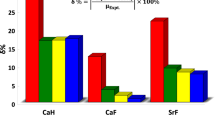Abstract
The embedded atom method potentials calculated earlier for liquid lithium, sodium, potassium, rubidium, and cesium and presented in the form of tables are corrected and represented in a unified analytical form. When the parameters of the potential are adjusted using the known temperature dependence of the melt density along the melting line of the metal, the actual energy rises more rapidly than the simulated energy as the critical point is approached. The likely reason for the discrepancy is the thermal contribution of the electron gas to the energy of the metal. The discrepancy between the simulated energy and the actual energy of the metal at high temperatures can be considerably reduced by taking into consideration the thermal excitation energy of the electrons.
Similar content being viewed by others
References
Belashchenko, D.K., The Use of the Embedded Atom Model for Liquid Metals: Liquid Potassium, Russ. J. Phys. Chem. A, 2009, vol. 83, no. 2, pp. 260–264.
Belashchenko, D.K., Embedded Atom Model for Liquid Metals: Liquid Iron, Russ. J. Phys. Chem. A, 2006, vol. 80, no. 5, pp. 758–768.
Belashchenko, D.K., Embedded Atom Model Application to Liquid Metals: Liquid Rubidium, Russ. J. Phys. Chem. A, 2006, vol. 80, no. 10, pp. 1567–1577.
Belashchenko, D.K., Application of the Embedded Atom Model to Liquid Metals: Liquid Sodium, High Temp., 2009, vol. 47, no. 4, pp. 494–507.
Belashchenko, D.K. and Nikitin, N.Yu., The Embedded Atom Model of Liquid Cesium, Russ. J. Phys. Chem. A, 2008, vol. 82, no. 8, pp. 1283–1289.
Belashchenko, D.K. and Ostrovskii, O.I., Application of the Embedded Atom Model to Liquid Metals: Liquid Lithium, High Temp., 2009, vol. 47, no. 2, pp. 211–218.
Finnis, M.W. and Sinclair, J.E., A Simple Empirical N-Body Potential for Transition Metals, Philos. Mag. A, 1984, vol. 50, pp. 45–55.
Daw, M.S. and Baskes, M.I., Embedded-Atom Method: Derivation and Application To Impurities, Surfaces, and Other Defects in Metals, Phys. Rev. B: Condens. Matter Mater. Phys., 1984, vol. 29, no. 12, pp. 6443–6453.
Belashchenko, D.K., Optimal Algorithm for Constructing the Embedded Atom Method Potential for Liquid Metals, Inorg. Mater., 2011, vol. 47, no. 6, pp. 654–659.
Schommers, W., A Pair Potential for Liquid Rubidium from the Pair Correlation Function, Phys. Lett. A, 1973, vol. 43, pp. 157–158.
Belashchenko, D.K., Molecular-Dynamics Simulation of the High-Pressure Properties of Rubidium, High. Temp., 2010, vol. 48, no. 5, pp. 646–658.
Belashchenko, D.K. and Smirnova, D.E., Modeling the Molecular Dynamics of Liquid Metals at High Pressures: Liquid Potassium, Russ. J. Phys. Chem. A, 2011, vol. 85, no. 11, pp. 1908–1916.
Bystrov, P.I., Kagan, D.N., Krechetova, G.A., and Shpil’rain, E.E., Zhidkometallicheskie teplonositeli teplovykh trub i energeticheskikh ustanovok (Liquid-Metal Heat Transfer Fluids for Heat Pipes and Power Plants), Moscow: Nauka, 1988.
Waseda, Y., The Structure of Non-Crystalline Materials. Liquids and Amorphous Solids, New York: McGraw-Hill, 1980.
Salmon, P.S., Petri, I., de Jong, P.H.K., et al., Structure of Liquid Lithium, J. Phys.: Condens. Matter, 2004, vol. 16, pp. 195–222.
Animalu, A., Intermediate Quantum Theory of Crystalline Solids, Englewood Cliffs: Prentice-Hall, 1977.
http://chemfiles.narod.ru/element/k/k.html. Potassium: Chemical Elements: Chemistry-files.ru
Hosokawa, S., Pilgrim, W.-C., Hensel, F., et al., X-Ray Diffraction Measurements on Expanded Liquid Rb, J. Non-Cryst. Solids, 1999, vols. 250–252, pp. 159–162.
Winter, R., Hensel, F., Bodensteiner, T., and Glaser, W., The Static Structure Factor of Cesium over the Whole Liquid Range up to the Critical Point, Ber. Bunsen-Ges. Phys. Chem., 1987, vol. 91, pp. 1327–1330.
Belashchenko, D.K., Smirnova, D.E., and Ostrovski, O.I., Molecular-Dynamic Simulation of the Thermophysical Properties of Liquid Uranium, High Temp., 2010, vol. 48, no. 3, pp. 363–375.
Author information
Authors and Affiliations
Corresponding author
Additional information
Original Russian Text © D.K. Belashchenko, 2012, published in Neorganicheskie Materialy, 2012, Vol. 48, No. 1, pp. 87–94.
Rights and permissions
About this article
Cite this article
Belashchenko, D.K. Embedded atom method potentials for alkali metals. Inorg Mater 48, 79–86 (2012). https://doi.org/10.1134/S0020168512010037
Received:
Published:
Issue Date:
DOI: https://doi.org/10.1134/S0020168512010037




